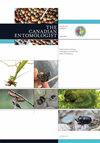Parasitism of Adult Poecilus versicolor (Coleoptera: Carabidae) by Hymenopteran Larvae
IF 1.1
4区 农林科学
Q3 ENTOMOLOGY
引用次数: 5
Abstract
Abstract We report the presence and effects of parasitoid larvae (Hymenoptera) in the carabid beetle Poecilus versicolor (Sturm). Dissection of one female and one male live host found 33 and 25 hymenopteran larvae, respectively. Although eggs were absent in the female host, likely because of consumption by parasitoids, distinct corpora lutea (present in parous females) were observed. In the male host, reproductive organs were undamaged. These observations suggest incomplete “parasitic castration” of the host beetle by the parasitoids. Parasitism rates in specimens from three localities were markedly low (0%–3.2%). At one locality, only one male and three female beetles containing parasitoids were found; those individuals each contained 9–27 larvae (mean 19.3). These results suggest that hymenopterous parasitoids in adult P. versicolor have little effect on the population dynamics of this beetle. The parasitoid larvae included two morphological types belonging to at least two taxa. Mitochondrial DNA analyses suggested that one of the types represented two species of Microctonus Wesmael (Braconidae: Euphorinae). The result of the genus-level identification, however, requires confirmation because the analyzed data set did not cover all braconid genera.膜翅目昆虫幼虫对花斑小蜂成虫的寄生作用
摘要本文报道了紫瓢虫Poecilus versicolor (Sturm)中寄生性幼虫(膜翅目)的存在及其作用。解剖1只雌蜂和1只雄蜂,分别发现膜翅目幼虫33只和25只。虽然雌性寄主体内没有卵(可能是因为被寄生蜂吞噬),但观察到明显的黄体(存在于已产雌性体内)。在雄性宿主中,生殖器官未受损。这些观察结果表明寄主甲虫被寄生蜂不完全“寄生阉割”。3个地区标本的寄生率均较低(0 ~ 3.2%)。在一个地方,只发现1只雄性和3只雌性甲虫携带寄生蜂;每个个体含9 ~ 27只幼虫,平均19.3只。这些结果表明,成虫中的膜翅类寄生蜂对花斑瓢虫的种群动态影响不大。寄生幼虫包括两种形态类型,至少属于两个分类群。线粒体DNA分析表明,其中一种类型代表两种威斯马小仓鼠(小仓鼠科:大仓鼠科)。然而,属级鉴定的结果需要确认,因为所分析的数据集并未涵盖所有的尾鱼属。
本文章由计算机程序翻译,如有差异,请以英文原文为准。
求助全文
约1分钟内获得全文
求助全文
来源期刊

Canadian Entomologist
生物-昆虫学
CiteScore
2.20
自引率
11.10%
发文量
24
审稿时长
6-12 weeks
期刊介绍:
French translation follows/le français suit Published since 1868, this peer-reviewed bimonthly publication is the official journal of the Entomological Society of Canada. Available via the internet and with hardcopy distribution to 55 countries, its research papers and notes are relevant to entomologists and other biologists around the world. In addition to being a venue for topical reviews and forum discussion, The Canadian Entomologist publishes current research in all facets of entomology, including systematics and morphology, molecular and developmental biology, ecology and behaviour, biodiversity and evolution, insect management, entomological techniques, and other relevant subject areas. Contributions are published in English or French. Authors will not pay page charges, and will experience fast, high quality reviews of their papers.Publiée depuis 1868, cette publication bimestrielle avec comité de lecture est la revue officielle de la Société d’entomologie du Canada. Disponible sur Internet et distribuée en format papier dans 55 pays, ses articles de recherche et ses notes sont pertinents pour les entomologistes et autres biologistes de par le monde. En plus d’être une plate-forme pour des revues thématiques et un forum de discussion, The Canadian Entomologist publie la recherche actuelle sur toutes les facettes de l’entomologie, incluant la systématique et la morphologie, la biologie moléculaire et développementale, l’écologie et le comportement, la biodiversité et l’évolution, la gestion des insectes, les techniques entomologiques et d’autres domaines pertinents. Les contributions sont publiées en français ou en anglais. Les auteurs ne paient aucun frais de publication, et recevront une révision rapide et de grande qualité de leurs articles.
 求助内容:
求助内容: 应助结果提醒方式:
应助结果提醒方式:


